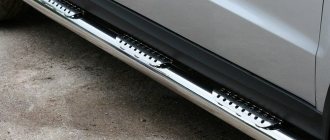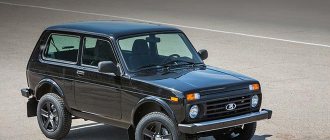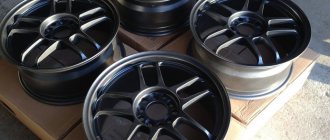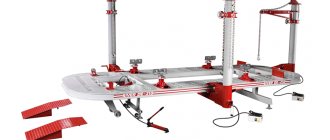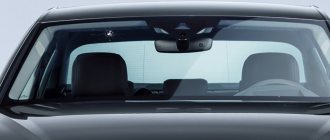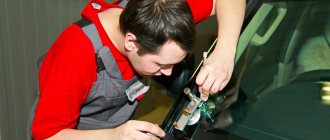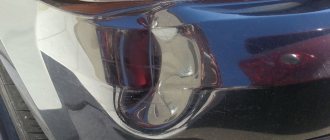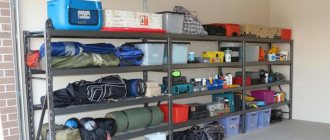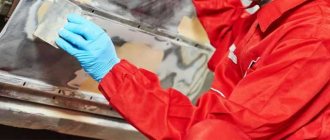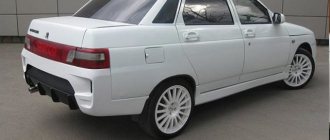Welcome to the kuzov.info blog!
In this article we will look at the structure and operating principle of hydraulic stretching and how it is used in body repair.
To eliminate emergency deformation of the car body, a strong impact is required in the direction opposite to the impact. For this purpose, hydraulic stretching is used. It provides sufficient pressure with minimal effort for the master. The most common are “hydraulics”, capable of exerting a force of 4 and 10 tons.
The importance of controlling and maintaining body geometry
So much has been said about the fact that the stocks are capable of restoring body geometry. At the same time, not everyone fully understands why this is done and why the machine cannot be operated with any deviations relative to its factory geometry.
Body geometry or body geometry refers to the exact dimensions of a vehicle, specified at the production stage. Key parameters include:
- front track width,
- rear track width,
- wheelbase length,
- length of the side members,
- distance between side members.
The body consists of a large number of parts that form a supporting system. During normal use, parts begin to shift slightly. This is due to the less than ideal condition of the road surface, vibrations, collisions with bumps and holes, sudden forced braking, etc. A process of natural wear and tear occurs, which can be characterized as metal fatigue.
But under normal conditions this process proceeds very slowly. But there are situations when the shift occurs suddenly and sharply. This is possible in case of an accident, serious mechanical damage, when the car falls into a large hole at high speed, or in collisions with obstacles. As a result, the geometry is violated, that is, the car no longer meets its factory standards.
In such situations, high-quality restoration of the modified geometry of the car body helps. It can be restored on the slipway. This type of repair allows you to restore the car after accidents and continue normal operation.
If you ignore the need for repairs, this may manifest itself in the form of the following problems:
- doors don't close well,
- The hood and trunk do not close tightly,
- the car behaves unstably at high speed,
- the car skids even though the steering wheel is straight,
- the car stops obeying the driver,
- vibration appears
- the metal gradually deteriorates,
- the load increases,
- body elements and associated components wear out,
- fastenings are destroyed.
How dangerous all this is, each of you can guess for yourself.
Therefore, it is important to check the geometry not only in the event of an accident and various types of severe damage, but also after a fairly long service life of the car
Some car owners, in order to prevent and prevent the development of problems, carry out diagnostics of the condition of the body at least once every 2 years. This is especially true for those who are forced to travel on bad roads, which contribute to rapid wear of body elements and accelerate metal fatigue.
Body stocks are objectively sometimes irreplaceable equipment in matters of vehicle repair. They help in restoration and extend the life of the car.
To what extent such an installation is needed at home is an extremely controversial issue. But every auto repair shop that provides body repair services is simply obliged to have a professional and high-quality slipway at its disposal.
Homemade equipment
Creating a homemade slipway for straightening the body will save money, since they are expensive. When designing, you should take into account the dimensions of the future device for car repair and create a drawing of the device. You can order it from specialists, or find a ready-made one on the Internet. Depending on the type of exhaust mechanism, the set of tools and materials that will be needed differs.
Manufacturing of a mobile slipway
To make a mobile body straightening device yourself you will need:
- From a profile more than 4 mm thick, you need to create a frame with dimensions twice the dimensions of the machine.
- The structure is strengthened by cross members and corner elements. The crossbars will be used to secure the car. Exhaust mechanisms are also attached to them.
- To make the structure mobile, four wheels are attached to the bottom.
- To be able to lift the car onto the frame, a gangway is constructed. On one side they will have a special plug, and on the other a removable section necessary for lifting the vehicle.
- The structure is equipped with a bench vice or special clamps. They are needed to securely fix the machine.
Manufacturing of a stationary slipway
When constructing a straightening stand with your own hands, the channel is concreted and also reinforced with cross members of a rigid structure. The optimal material for creating a “hospital” is a metal profile with a section of 40 by 80 mm. The length is determined depending on the dimensions of the car.
Next, four fasteners are installed around the perimeter of the frame, which are intended for a vice that clamps the machine. They move perpendicular to the channel, thanks to which damage of any size can be repaired. The car is placed on a stand for body repair using a jack: first the front part of the car is lifted, then the rear. In a garage or auto repair shop, you will need to install special eyes necessary for attaching the chain.
The slipway is the necessary equipment for do-it-yourself body repair. The device eliminates damage to the car body. When restoring the machine body yourself, an exhaust mechanism is also necessary.
A slipway is a special device (platform) that is designed for body repair and restoration of the original geometry of the body using multidirectional forces. A high-quality factory-made slipway is quite expensive and it is not advisable to purchase it for small-scale and rare body work. You can do it yourself, and the price for a homemade slipway will not be so high.
Top ads View all
Spotter (spotter). Spotter for straightening metal (cars)
6,700 UAH.
Spotter for aluminum and steel Dent Hunter, dent straightening, PDR
Guaranteed to receive the goods or money back to the card More details.
20,800 UAH.
Straightening dents. PDR, paintless dent removal. Reverse hammer
Tools » Hand tools
2,000 UAH.
Straightening without painting. Straightening dents. Kit. PDR
Tools » Hand tools
Guaranteed to receive the goods or money back to the card More details.
1,200 UAH.
Dent straightening kit. PDR. Straightening without painting. Dent Removal
6,600 UAH.
What is a slipway for body repair
A slipway is specialized equipment designed to completely restore the main frame of a car, as well as the geometry of the entire body. It makes it possible to correct body irregularities and restore normal parameters by applying different forces in many directions. In many cases, traffic accidents lead to deformation of the car body or deformation of its frame. In such cases, it is the slipway that becomes the most important tool for body repair and the main task, namely straightening the curved body, fully becomes its task.
Calculation of required materials
Before starting work on the manufacture of a slipway, it is necessary to complete its drawing and calculate the amount of materials required. The platform should look like a rectangle (or better yet, several) made of metal profiles with a cross-section of 50×50 or 70×40 (the thicker the better). The optimal length is 2000 mm, the width is equal to the width of the car's wheelbase.
Why was this width chosen? In general, it is possible to manufacture a slipway with a width equal to the width of the wheelbase of the car. Or smaller than it, but with extensions from the frame on which the clamps will be attached. The first method is preferable due to the location of the clamps.
In the middle of the platform it will be necessary to weld a stiffener from a similar metal profile. During the work, additional metal will be required, the amount of which is difficult to calculate at the initial stage of work.
After the calculation of the required amount of metal profile has been completed, it can be ordered from a special database or you can use an existing one.
To ensure the functionality of the slipway, it will need to be equipped with good hydraulics - a kit with a tonnage of up to 10 tons is suitable.
You also need to remember that there are two types of slipway: stationary (that is, installed in a specific place without the ability to move) and mobile (equipped with wheels and adapted for storage in a vertical position). If the second option is chosen, then you also need to purchase a set of wheels: 4 or more for the frame, 2 for the power rack.
Exterior modernization
The Niva SUV is one of those cars that are not afraid of experiments. The model is “omnivorous” in terms of body tuning and readily accepts all popular innovations. Of primary importance in this direction are protective equipment, among which is crankcase protection. This component will prevent damage to the power unit and other components located close to the bottom of the car. Also, external tuning of the VAZ-2121 provides for the installation of reinforced thresholds. This addition will not only be a good assistant in operations with the jack, but will also make the operation of the machine more convenient in general. The aerodynamic characteristics of the SUV are improved thanks to a special body kit, grilles, spoiler and air intakes. Finally, connoisseurs of aesthetics can recommend body airbrushing, which will emphasize the brutal character of the updated Niva.
How to make a slipway with your own hands
So, when everything is ready, you should start making a slipway for body repair. All parts must be degreased in advance, coated with a primer, and then painted with powder paint using a spray gun. Then the metal corners must be welded to the profile, which will be the base. Next, a longitudinal profile is welded as a stand and secured with bolts. Then power and retractable devices, chains and hooks are installed. After you have built a slipway, you need to test it and check the effect of each device.
The repair process is quite simple: the exhaust mechanisms are started, and the pressure of the power devices activates the slipway. Thus, you can independently repair damage to your car of any level of complexity.
Levers and bump stops
Levers and bumpers are used to straighten out dents from the inside. The lever is easy to make with your own hands. It can be an oblong pin or a flat bar. The dimensions of the tool should be no larger than the technological hole through which it will be used.
Fenders are more difficult to obtain. This equipment cannot be made with your own hands without special skills. A suitable option is to purchase the device at a car dealership. It is recommended to use fenders containing fluoroplastic. A set of levers and bumpers provides the necessary pressure and minimizes the risk of damage.
The disadvantage of these tools is the inability to remove dents all over the car, since their use requires technological holes.
Do-it-yourself slipway for body repair
A slipway is complex repair equipment that requires professional skills, both in operating the device and in assembling it. The slipway is made with your own hands from standard devices:
- Metal profile 150 cm long with a section of 40x80 mm.
- A steel longitudinal profile with a section of 20x40 is suitable for support posts.
- The corners will be needed for welding to the posts.
- Welding machine.
- Fine thread bolts and nuts.
- Fasteners (best suited for foreign cars).
- Anti-corrosion epoxy primer.
- Powder paint, spray gun.
- M10 bolts.
- Hydraulic device with a thrust level of at least 4 tons.
- Powerful chain with hook.
To assemble a slipway you need drawings to do it right. Without them, problems and inconsistencies in parts may arise.
bench for body repairDrawings can be found on the Internet. The construction of the slipway elements proceeds as follows:
- Corners with holes for bolts need to be welded to the metal profile that serves as a transverse beam. You will get a stand with grips. If a slipway is required for one machine, then all holes must be made according to individual parameters.
- It is better to reinforce the longitudinal steel profile - racks - with corners. This is required to properly capture the thresholds of the car. The minimum height of the stand is 25 cm.
Before starting installation work, all parts must be powder coated. Paintwork is also suitable, but the first option is higher quality and more reliable:
- All elements of the future slipway must be cleaned and degreased, and then coated with a corrosion-resistant primer.
- After priming, car repair tools should be sprayed and allowed to dry completely.
After this, the installation process continues:
- It is recommended to fix all racks with M10 bolts. They serve well when working with hydraulics of any traction level.
- The resulting slipway must be placed in the workspace, taking into account the minimum parameters: a passenger car must fit freely on the stand, and there must be no foreign objects that interfere with the movement of the slipway.
- Finally, all that remains is to attach the chains and grips.
https://www.youtube.com/watch?v=K4U2WowlesI
How to make a slipway with your own hands, you ask: drawings, materials, and auxiliary tools are freely available, so the work of assembling your own repair stand is within the power of every car owner. There would be a desire.
Do you want to know everything about car painting? Read more useful articles:
- Hammer enamel. Have you tried painting it?
- Spot painting of a car. How to do it right.
- Hand spray gun. What manufacturers are silent about.
Magnet
A magnet is a device used to pull out dents. The device is used together with a rag, which is placed under it at the time of use. This condition ensures protection of the coating during leveling.
The device is used to smooth out small damage. Using this tool does not require labor-intensive physical effort. The easiest way to pull out a dent is with a magnet, so you can carry out restoration work yourself.
A magnet for straightening the coating is a special device sold in car dealerships. It is not recommended to use homemade devices for this purpose.
What type of slipway do you need?
In order to create your own slipway, you first need to decide what type you will need. There are three different types of slipway.
Frame
Frame slipway. This type of slipway is a simple frame. The damaged car is secured to it and a strong chain is attached to the place of severe deformation of the side members. Using powerful hydraulics, the damaged area is pulled out by this chain. The disadvantage of this design is the mandatory presence of a lift, so that it is possible to adjust the position of the car at a height.
Slipway-platform
Slipway-platform. This type of slipway refers to a more professional type of body repair. It looks like a platform on which a system of hooks and holes is located - these are fastenings. Like a frame structure, a platform slipway is equipped with a lift, but unlike a frame, such slipways often have several towers. Towers are the place by which you can pull the body - the more of them, the better and more varied the repair - the body can be pulled in different directions at the same time. The main device also remains a powerful hydraulic device. The disadvantages include large overall dimensions.
Floor
Floor slipway. This type of slipway is mainly used by professional auto body repair companies. The power of such a slipway is enough to restore the geometry of any vehicle, even a truck. A force of up to 10 tons can straighten even the channel frame of a mining dump truck. The fact is that in such a slipway there are too many components that are simply not needed by an ordinary garage mechanic. A bodybuilder who plans to create such a homemade slipway simply will not be able to take advantage of the full potential and power of such a slipway.
Car dent removal kit (mini lifter) PDR
- Price: $33.99
- Go to the store
Hi all! Today in my review I’ll tell you about a kit for removing dents on a car, whether it works, and whether it’s possible to straighten your car like this without experience. Details under the cut
PDR technology is the repair of dents on a car body without painting, that is, with full preservation of the factory paintwork.
The first tool that a PDR specialist picks up is a special lamp that helps to “read” the dent, that is, assess its size, depth, and the condition of the paint layer. Repair is not complete without hooks, which are used to squeeze out dents from the inside out, and without an adhesive system that allows you to correct the geometry of the part from its outside if there is no access to the inside. The main method of removing dents is done using various hooks, like these
I will only use glue technology, although this is not correct, because it takes a long time and is not so effective.
To do this, I took a kit (minilifter + fungi + bumper) and additionally ordered glue
Using a mini-lifter you can remove dents whose diameter does not exceed 1-2 cm.
The set includes 10 mushrooms of different sizes (in the photo I sharpened one and lost one). The fungi need to be glued to the dent and pulled using a mini-lifter. I have no complaints about fungi, they do their job.
I immediately ordered hot melt glue, it seems to be special, but you can also use it from a hardware store. A set of 10 pieces (5 black and 5 yellow) costs $6.90.
Yellow is soft, black is a little harder, but softer than the transparent one from the hardware store.
there's even some markings
I used yellow glue, it sticks and pulls perfectly.
This is interesting: What is the reason for the viburnum to start and immediately stall?
Let's get to work!
Although it’s difficult to convey the depth and shape of the dent in a photo, I’ll try. Focus more on words.
First you need to degrease the dent, then warm it up with a hairdryer (without fanaticism)
Then we apply glue from a heat gun to the fungus
and glue it exactly in the center of the dent
We wait about 1 minute (approximately) and begin to pull with a minilifter
You need to slowly, smoothly pull out the dent. To peel off the fungus, you need to spray alcohol and the glue will bounce off. The dent has become smaller, but has not gone away (look at the hook)
I made a short video, at the end I peeled off the fungus myself so as not to overtighten it.
I have no questions about the instrument itself; in the right hands it will work as it should.
Thank you for your attention, good weather everyone
